FedEx PEST and Porter’s Five Forces Analysis
Info: 8461 words (34 pages) Dissertation
Published: 24th Aug 2021
Tagged: BusinessPESTLEBusiness Analysis
Contents
Company History 3
Company Structure 5
Industry Overview 6
Political/Legal 8
Economic 13
Social/Cultural 15
Technological 18
Industry Analysis FedEx (Porter’s Five Forces)
Threat of New Entrants 21
Bargaining Power of Suppliers 24
Bargaining Power of Buyers 25
Threat of Substitute Products 26
Rivalry Amongst Competing Firms 27
Industry Analysis FedEx Office (Porter’s Five Forces)
Threat of New Entrants 31
Bargaining Power of Suppliers 32
Bargaining Power of Buyers 32
Threat of Substitute Products 32
Rivalry Amongst Competing Firms 33
References 35
Company History
First Stage -The Beginning 1965-1977
In 1965, Yale University student Frederick proposed that logistics facing a problem with urgent shipments couldn’t reach in time with only relied on passenger route systems. Frederick came up with an idea of a system specifically designed to use for time-limited shipments such as computer parts, electronics and medicine. In 1971, the idea of FedEx Express was born due to Frederick’s idea using in his company with struggled delivering shipments within small time of amount. Frederick first named the company Federal Express because of the patriotic meaning and related to Federal Reserve Bank to get loan. However, the bank rejected his application. Frederick choose Memphis, Tennessee to be the headquarter because the location is in the middle of United states and the airport rarely shut down due to the weather. In 1973, FedEx was officially opened by 389 members. FedEx reached the first milestone with one night delivered 186 packages to 25 cities in United States. In 1977, FedEx bought seven Boeing 727 aircrafts shortly and the profit changed from $8 million to $110 million. At the time, FedEx had regular customers including US air force and IBM.
Second Stage- The expanding 1983-2009
In 1983, FedEx had regular shipments to Europe. FedEx looked to develop an international presence and expand its services by establishing a European spot at the Brussels airport. In 1988, the firm expanded to Japan. The major global destinations targeted Europe and Asia. During 1991-2000, FedEx has expanded the range of delivery and different systems to make shipping more efficient. The destination from only Tokyo extended to China, Mumbai and opened an Asia Pacific hub in Subic Bay International Airport in the Philippines. FedEx provided the first transportation website for customers tracking their packages online and organizing their business online.
Third Stage- Current Operation 2011-Present
FedEx has been expanding the network into more local destinations in every country. The firm tries to connect from Europe straight to Asia. FedEx launches a bridge with a direct round trip flight operating five days a week between Hong Kong and Paris. This was a huge breakthrough for carriers all over the world. In 2006, FedEx broke a record in carrier industry during holidays where in December, FedEx had a record-breaking 9.8 million packages move through its global FedEx Express and FedEx Ground networks. “Achieving this milestone speaks to our world class global workforce, our strong heritage and leadership both for today and future.” said Frederick W. Smith.
Company Structure
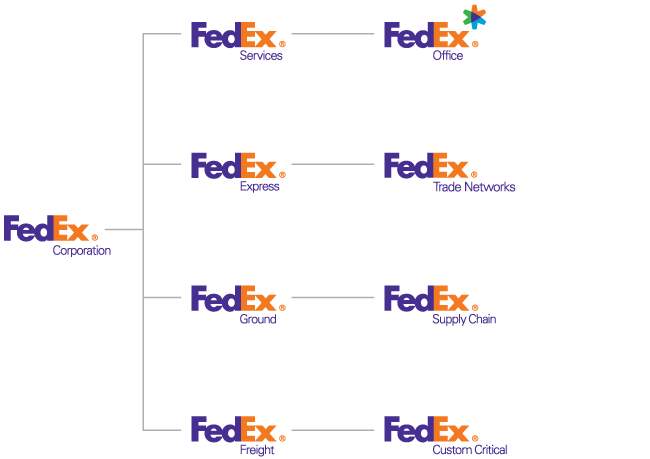
Structure
FedEx has five headquarters located all over the world. The biggest headquarter is in Memphis, Tennessee. The Asia headquarter is in Hong Kong. The Canada headquarter is in Toronto. The Europe headquarter is in Brussels, Belgium. The Latin America headquarter is in Miami, Florida. FedEx corporation includes FedEx Services, FedEx Express, FedEx Ground and FedEx Freight. FedEx Services was founded in 2000 to provide sales, information technology and marketing for corporation. In 2013, FedEx Services reached a milestone of providing customers with a range of flexible options to forecast the date of delivery. This service helps a lot of companies make their work more efficiently. FedEx Services has another company to support the chain- FedEx Office. FedEx Office focus on retailer, small business, and home business people. On the other hand, FedEx Ground supports the corporation with local inland service to reach different destination with fast speed and tracking systems. The idea was born since 1985 from a started up company called Roadway Package System (RPS). They put barcode outside of each package to track. The core of FedEx ground is to provide city-to-city service and compete local UPS. The FedEx Freight is focusing on Less-than-truckload (LTL) shipping. Back in 1966, the idea was from Viking Freight. After years’ advanced, it creates FedEx Freight nowadays with the same concept.
Industry Review
In today’s strong network world where many utilize the service of shipping needs, logistic plays an important role. International logistic is a matter of physical circulation cross countries to countries. In the process of circulation, the process includes transport, storage, loading and unloading, packaging, and customs. The well-known carriers in the world dominate the market share FedEx 23.2%, UPS 54.8%. The key drivers of the industry are corporate profits, e-commerce, consumer spending, and the number of businesses. Delivery services are expected to grow as consumer spending and corporate profit are expected to increase in future years. The decline of brick-and-mortar stores and rise of e-commerce will increase shipping and improve this industry (IBIS, 2017).
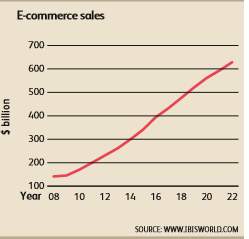
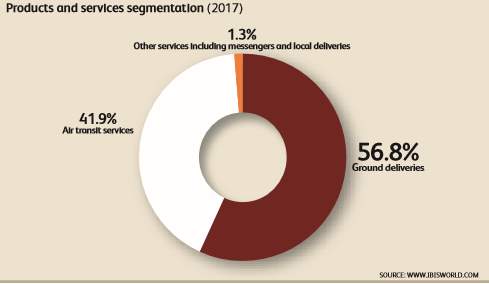
The logistics in United States is highly competitive. According to statistic, there were $1.48 trillion spending on logistic in 2015 in US. The number was 8% of the annual gross domestic product which is very high percentage overall. Carriers are the bridges between producers and consumers. The statistic of revenue of logistic in United States in 2017:
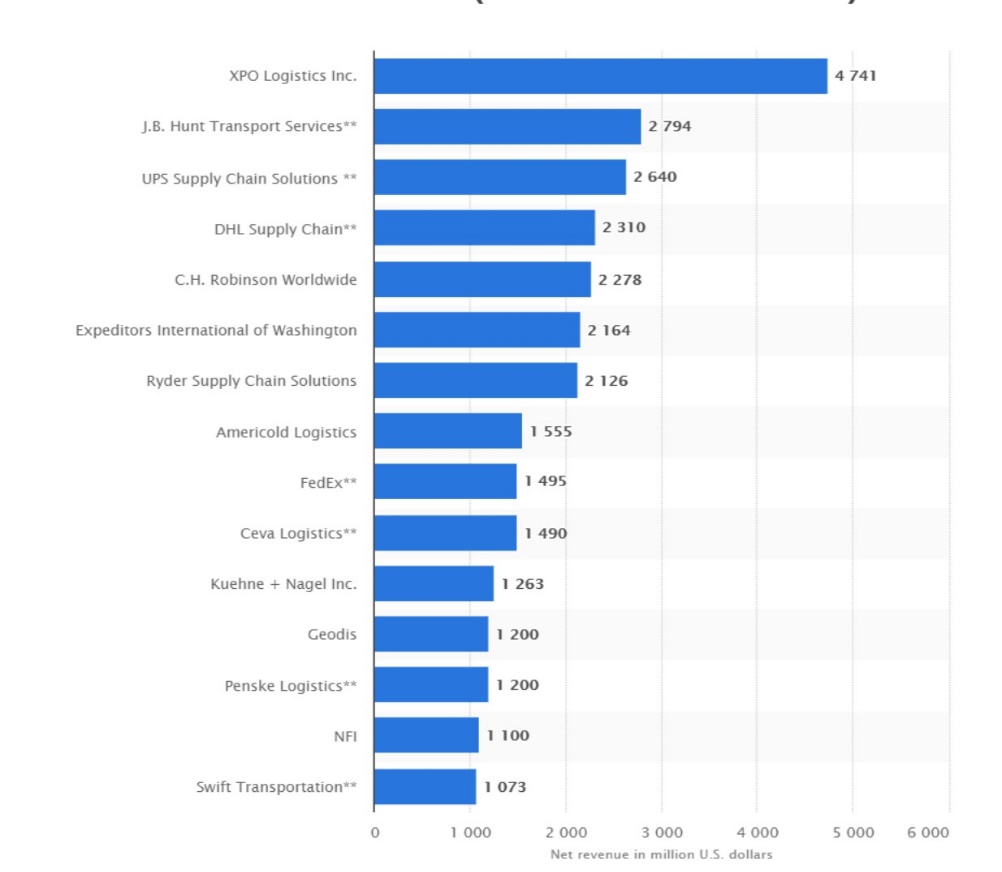
In addition to demand, the operating cost have benefited from drop in oil prices allowing lower prices for consumer demand. The combination of low unemployment, higher income levels, and reduces cost further supports the industry opportunity.
Environmental Analysis (PEST)
Political/Legal Segment
Because of the impact of competing economic dominance between countries, FedEx is exposed to several significant political legal forces that impact the industry and FedEx. Many of these forces occur in the international operational area. These political and legal forces are restrictive government regulations, political instability, and employee training program. Often, these factors target specific industries with the intent to boost economies. Restrictive governmental regulations in the ranges from constringent domestic laws limiting the operational freedom, ownership, and investment source a company may have within its border, to employee protection laws. In China, the logistics industry remains highly regulated due to governmental partnership with locally owned businesses. In 2001, China’s membership into the World Trade Organization opened the country for foreign investments. In 2005, it opened the logistics and express delivery industry to foreign firms. In 2009, the Chinese government enacted a new postal law that required the foreign firms to acquire licenses from the department of postal management and the department of merchant and trade for both the domestic and international delivery business. In addition, the Postal Law indicated that the governmental firm (EMS) only can deliver letters and documents that weigh less than 5kg, and packages which weigh less than 10kg. Moreover, foreign delivery companies are only allowed to deliver express packages within China and deliver express letters internationally. These regulations restrict the coverage and business scope of the international delivery firms in China (Ryu et. al, 2014). In 2014, the Chinese government issued domestic logistics operational license to foreign owned companies due to its increasing population, inability of locally-owned business service across the country and forecast of population growth in 225 cities by 2025. FedEx received 21 cities license while UPS, a global competitor received 14 (Reuters, 2014). The licenses permit foreign owned logistics companies to independently establish and operate within specific cities. This alleviate the stress attached to forming a joint company with Chinese companies under the previous law. In addition, the new law creates business opportunities for companies to expand their scope of operation to business-to-consumer (B2C) platform, increasing FedEx role as an intermediary between businesses and consumers within the approved cities.
Secondly, the employment laws of the host country impacts company policies for hiring employees, work-payment schedule, and termination. Employment laws in the Europe, U.S and Canada are similar has it equally protect the rights employees and employers. In China, Foreign companies like FedEx are not allowed to employ a foreigner if the expertise required for the position is available within the Chinese population (Silkin, 2017). Furthermore, the maximum required hours to be considered a full-time employee at a company is different in each country. In China, Philippines, and Indonesia, the legal full-time hours are 8 hours per day, while in Singapore employees may work up to 12 hours per day but must not except 44 hours per week (Singapore Ministry of Manpower, 2011). Another factor is the minimum wage enforced in FedEx operating countries. The minimum wage in Mexico is $4.70 per hours (Harrup, 2017), in Philippines, the daily nominal minimum wage is $9.49 (Philippines Department of Labor, 2018), and Singapore does not have a set minimum wage (Singapore Ministry of Manpower, 2011). In order to protect, it citizens from mistreatment or servitude, the governments have labor laws that foreign companies must follow in order to operate legally within the country. For instance, the Government of Singapore requires that a company must inform an employee of the intent to terminate his or her employment prior to the execution of the act. The termination must be on the basis of misconduct, end of contractual obligation, or organizational restructure. The termination notification duration is based on years of service to the company (Singapore Ministry of Manpower, 2011).
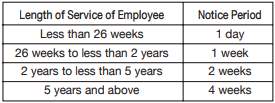
In contrast to Singapore, terminating an employee in Philippines is a-bit more stringent. Terminating employment is relatively restrictive from an employer’s perspective and must be carried out in compliance with statutory requirements to avoid fines, and loss of operating license. Termination by an employer is only legal if there is a just or authorized cause. The employer may not dismiss an employee at any time without cause by merely giving notice or payment in lieu of notice. Serious misconduct, gross and habitual neglect, fraud or willful breach, or the commission of a crime are terminable examples of just cause, while installation of labor-saving devices, redundancy, retrenchment to prevent loss, cessation of operation, and disease are examples of authorized cause. In order to legally dismiss an employee due to a just cause, the employer must serve a written notice to the employee setting out the reason and giving the employee an opportunity to respond. If the employer decides to proceed with the termination, another written notice must be served to the employee. Termination on grounds of an authorized cause is slightly different. The employer must serve a written notice to the employee and to the Department of Labor and Employment at least 30 days before the effective date of termination. Unlike termination due to just cause, employees are entitled to receive statutory severance pay equivalent to at least one-half to one months for every year of service (Silkin, 2017). The difference in the termination laws has an important impact of the daily operational activity within the industry and within FedEx. The impact requires the companies within the industry to establish a process addressing each country of operations’ labor laws and cost of legal counsel within the country.
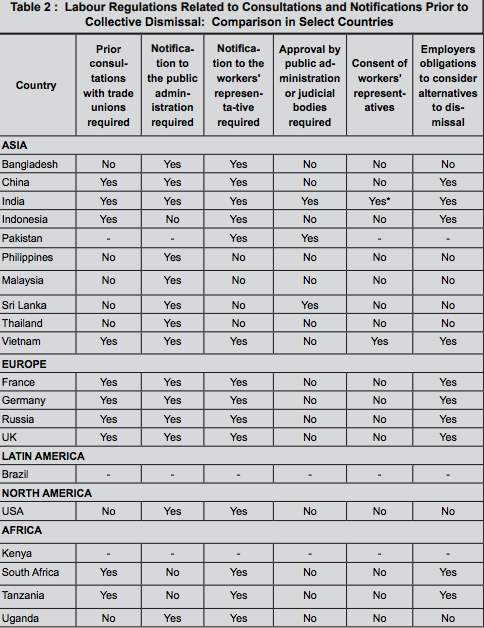
Source: International Labor Organization; Industrial Disputes Act for India (1947) for India; Exim Research
Economic Segment
Effectively understanding the economic effect of the global logistics industry requires the examination of unemployment rate, consumer spending behavior, GDP, and the parallelism of capability, demand and profitability in the company’s area of operation. The global logistics industry witnessed steady growth in the recovery years following the global economic recession. From 2013 to 2017, the US courier and local delivery services observed a 3.2 percent growth, and it is forecasted to have an average growth of 4.0 percent within the next 5 years (IBISWorld, 2017). The growth coincides with the declining unemployment rates, consumer spending behavior, and the imploding rates of e-commerce shopping within the United States. Data retrieved from the U.S Department of Labor indicates that the U.S unemployment rate in January 2018 is 4.1% (US Department of Labor, 2018).
According to the U.S Department of Commerce, U.S. retail e-commerce sales for the fourth quarter of 2017, saw an increase of 3.2 percent (±1.1%) from the third quarter of 2017. Total retail sales for the fourth quarter of 2017 were estimated an increase of 2.7 percent (±0.4%) from the third quarter of 2017. The fourth quarter 2017 e-commerce estimate increased 16.9 percent (±1.1%) from the fourth quarter of 2016 while total retail sales increased 5.7 percent (±0.4%) in the same period. E-commerce sales in the fourth quarter of 2017 accounted for 9.1 percent of total sales (U.S Department of Commerce, 2018).
Global economies observed similar increase in consumer spending behavior, decrease in unemployment (except in regions of conflict), and increase of e-commerce trend into the B2C, and B2B global retail. The observed decreased in the U.S and Global unemployment rate correlate with the increase observed in the spending behavior of consumers. The current global unemployment rate is 5.7% while that of the U.S is at 4.1% (World Bank, 2018). The consumer spending behavior is evident is the reported retail market size. China is reported as the top country with consumer spending behavior while the U.S is second on the list (Zipser et al, 2016). The aforementioned trend indicates that the global economy is advantages to the logistics industry.
Furthermore, FedEx benefited from the growth observed in the global economy. Utilizing it capabilities, the company was able to strategically prioritize its 664 aircrafts and over 90,000 motorized vehicles to cover regions in the world with observable continuous growth (FedEx, 2018). For example, in correlation with the growth in the Asian Pacific region, FedEx operates in more than 30 countries in the region using the state of the art B757, B767F, and B777F aircrafts with over 400 flights per week, and more than 5000 vehicle fleets dedicated to provide service to consumers and business (FedEx, 2018). The coupling of the capability and the business opportunities gives FedEx a competitive advantage over its competitors in the APAC.
In response to the global going green trend and understanding the cost associated with operating on Fuel due to its over 90,000 vehicle fleets, FedEx has focused on using electric options in their vehicles in the effort to reduce the amount of oil consumption and greenhouse gas emissions. FedEx currently has the industry’s largest fleet of hybrid electric package- delivery trucks and is continuing to expand their vehicles (FedEx, 2018).
Social/Cultural Segment
Halik (2012) asserted that in order to conduct an effective social segment of pest on an industry or on a company’s entrance into an economy, certain variables must be considered. The social variables are the demographic data of the targeted region, literacy and educational level, diversity within industry activities operating within the region, living standards, local attitude towards immigration, and earning capacity (Halik, 2012). Effective comparison of a host nation’s sociocultural dynamic is important in order to objectively assess its effect on the logistics industry, and FedEx. The sociocultural aspects of the environment have an impact on the outcome of the Logistics Industry and FedEx strategy in its operating area. A literacy publication released in September 2017 by UNESCO Institute for Statistics depicts an increase in the global literacy rate. The literacy rate of Adults between the ages of 15 to 24 is at 91% while the adults between the ages of 25 to 64 is 86% (UNESCO Institute of Statistics, 2017). In addition, the report compares the literacy rate between sexes. The literacy rate of men is in the 90-percentile range while that of women is in the 80-percentile range. Furthermore, the report states that 49% of the global illiterate population are in Southern Asia, 27% of all illiterate adults live in sub-Saharan Africa, 10% in Eastern and South-Eastern Asia, 9% in Northern Africa and Western Asia, and about 4% in Latin America and the Caribbean, less than 2% of the global illiterate population live in the remaining regions combined (Central Asia, Europe and Northern America, and Oceania). The literacy of the next generation going to the Workforce pool is important to the survivability or profitability of the logistics industry and FedEx, due to the unlimited possibilities with technological advances. The employees will need to be literate in order to daily activities in support of operational requirements for the companies within the industry including FedEx.
Diversity in the logistics industry is important because of the continuous movement of equality in the global workplace. Recent governmental labor laws have force companies to create a diversity program in order to ensure the hiring, compensation, and termination of employment is neutral in the workplace. Hence, criminating the discrimination against an employee because of race, sexual orientation, and religious belief. Furthermore, in an attempt to tackle the disparities in the number of women in the global logistics industry, some regional associations are implemented programs to attract talented woman into the industry. In Australia, Transport and Logistics Skills Council (TLSC) estimated that 14 percent of the industry’s workforce are women in 2009 and 19% in 2014 (Transport and Logistics Skills Council, 2014). In addition, a 2014 study conducted by TSLC indicates an increase in the pay gap between the women and male counterpart. The pay gap in 2014 was 16.1%, while that of 2009 was 5.3%. In order for the industry to retain talent, and grow its workforce, diversity program must be created to address the disparity in the diverse workforce and the pay gap. In an effort to tackle such disparity, FedEx has a diversity inclusion program that addresses the disparity in its workforce.
Lastly, the effect of technology on daily activities cannot be ignored. Technology has made a huge leap in the last few years, most of the younger generations are accustomed to the technology advances, while many of the older generations (like the baby boom generation) are new to all the developments or unwilling to accept its onset. The technological advances forced companies to channel their sales effort to online platform for user on mobile, and tablet-shaped device, and computers. In an effort to retain the patronization of business from the older generation, technological companies created device to help older generations transition to the new-age of communicating, business activities, and shopping. A Pew research conducted in 2014, shows that the older generation face barriers in adopting technological advances based on three factors, physical challenges, skepticism on the benefits of the technology, privacy concerns, and the difficulties associated to learning to use the new technology (Smith, 2014). This poses a threat to the logistics industry and FedEx in regards to the workforce productivity as the older generations are living and working longer than their predecessors. Furthermore, it threatens the retention of consumers who are in the older generation category. The Logistics Industry and FedEx must be able to serve and accommodate all generation’s needs and wants.
Technological Segment
Technological breakthrough has presented challenges for the logistic industry. The challenges are the innovation to offer better service to the consumers, the proprietorship of knowledge, provision of round-the-clock customer service to consumers, and the easy transparency of service status to consumers. The logistics industry was challenged to invest in research and development in order to maintain profitability when compared to other industries. Bhandari asserted that the emerging new technologies are creating strategic opportunities for the organizations to build competitive advantages in various functional areas of management including logistics and supply chain management (Bhandari, 2013). As the industry face consistent demands for greater reliability at lower cost, thus compelling companies within the industry to develop innovative ways to distinguish their service from competitors while providing superb service Companies must use all means to remain competitive and profitable.
The competition within the industry has led to the development of tracking device like the Radio Frequency Identification (RFID) used in tracking movement of items from one location to another. The RFID uses radio frequency to transfer information and track information through tags that are attached to the shipped items. Other innovations are the use of warehouse robotics in fulfillment centers by Amazon, the development of Autonomous vehicles for long haul freight transportation by Mercedes Benz, use of drones for delivery of purchased items by Amazon in the US (Davies, 2015), and Alibaba in China (Xinhua, 2017), the use of EDI to transfer data from one computer to another (Williams & Frolick, 2001), and the creation of Sense Aware to monitor shipments’ end-to-end integrity, and location in real time by FedEx (FedEx, 2016). The system is available for limited-time licensure to third party from FedEx. Furthermore, the advances of 3-D printing allow companies to produce raw materials in a timely manner, hence cutting manufacturing cost in the long term.
FedEx has been a frontrunner in the logistic industry due to its investment to promote innovation in the industry. In an effort to provide real-time, and fast services to consumers, FedEx opened a Command and Control Center at its Memphis Super-Hub (FedEx, 2018). It is the satellite to ground-level operations system, that enables FedEx to deliver packages by the fastest, safest and surest route, in any weather condition. The center coordinates FedEx logistics worldwide. The system uses satellite and computer communications technology to monitor routing and traffic information in real time and acts as a weather management tool. From electric delivery vans to more fuel-efficient aircraft, FedEx continually pursues innovations to reduce our environmental impact. FedEx Freight is driving one of our latest initiatives to explore alternative fuel sources: compressed natural gas (CNG) (FedEx, 2018). The technological advances are advantageous to the logistic industry in terms of expansion of business lines, predictability of certain market indicators, but it is disadvantages to the industry’s aging workforce.
Porter’s Five Forces – FedEx
Porter’s five force analysis provides insight to the competitive environment and sustainability of FedEx multiple service areas. For purpose of this paper two industries within FedEX will be considered. First, the freight services which most identify with include FedEx Freight, FedEx Ground, and FedEx Express. Secondly FedEx Office provides an array of services outside of the shipping to add to the profitability of FedEx Corporation.
Shipping services have major carriers such as UPS, United Parcel Service, local delivery services to compete with the delivery shipping/freight charges of FedEx. With few major carriers are in the industry, UPS dominates with 54% of the market share (IBIS, 2017).
Threat of New Entrants: Barriers to Entry
There are considerable amounts of wide ranged obstacles for entering into the logistics and transportation industry. The threat of new entrants is low for key players like FedEx, UPS and DHL. Factors such as economies of scale, significant capital prerequisite, the need of distribution facilities, and government policies make it less favorable for any new competitors.
Economies of Scale: Larger corporations competing in the industry may have an advantage with economies of scale as their operating expenses are managed more effectively. With fixed costs being large, having higher volumes and synergies in the business is needed to maintain healthy margins. The operating margin for FedEx for years 2015 – 2017 has increased by more than 2% YOY. With revenues exceeding $60B in 2017 and acquisition and integration of TNT Express, FedEx now operates in 64 countries. Having companies operating individually and managed collaboratively within one brand, FedEx is the world’s largest express transportation and North Americas’ leading LTL delivery company. Leading with the strategy to expand its business operations into the same logistics and transportation space, FedEx Services segment provides customer service, back office support as well as retail access to customers, giving FedEx benefit of the economies of scale.
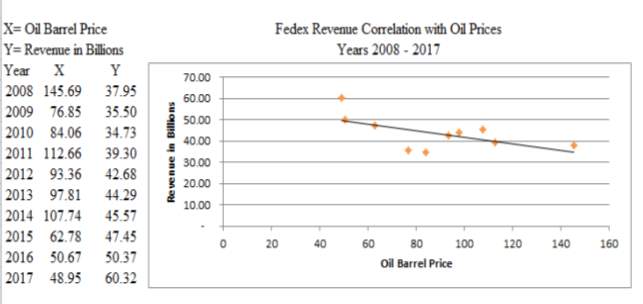
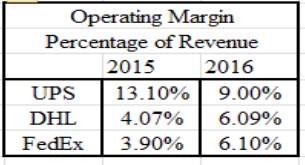
Significant Capital Prerequisite: FedEx’s capital expenditures for 2018 are expected to be approximately $5.9 billion (FedEx, 2017). There is a significant cost involved in purchasing or leasing the fleet required to move product. FedEx’s fleet currently comprises of 598 owned aircrafts, 59 leased aircrafts, 58,000 owned trailers and 57,000 owner-operated vehicles. Just in 2017, the company added 14 Boeing 767 and increased its spending on the existing Boeing 777 orders. FedEx must make commitments to purchase or modify aircraft years before the aircraft are actually needed (FedEx, 2017). These large-sum capital requirements are more than enough to keep a potential competitor from entering the market. From a liquidity standpoint, FedEx’s cash and cash equivalents totaled $4.0B at the end of May 2017.
FedEx Capital Expenditures by Category: Years 2015 – 2017
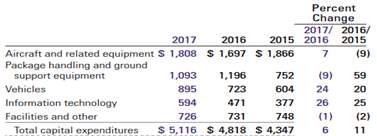
Need of distribution facilities: A large network of distributions centers is needed to serve the nearing geographies. FedEx Express’s primary sorting facility, located in Memphis, serves as the center of the company’s multiple hub-and-spoke system. A second national hub facility is located in Indianapolis. In addition to these national hubs, FedEx Express operates regional hubs in Newark, Oakland, Fort Worth and Greensboro and major metropolitan sorting facilities in Los Angeles and Chicago (FedEx 2017). Certain local as well as international facilities also provide sorting for express package and freight traffic moving to and from Asia, Europe and North America. Major sorting and freight handling facilities are also located at some of the airports. Throughout its worldwide network, FedEx Express operates city stations and employs a staff of customer service agents, cargo handlers and couriers who pick up and deliver shipments in the station’s service area (FedEx 2017). FedEx Office offers retail access and shipping services at all locations. As of May 31, 2017, FedEx Office had more than 1,800 locations.
FedEx Daily Volumes: Years 2014 – 2017
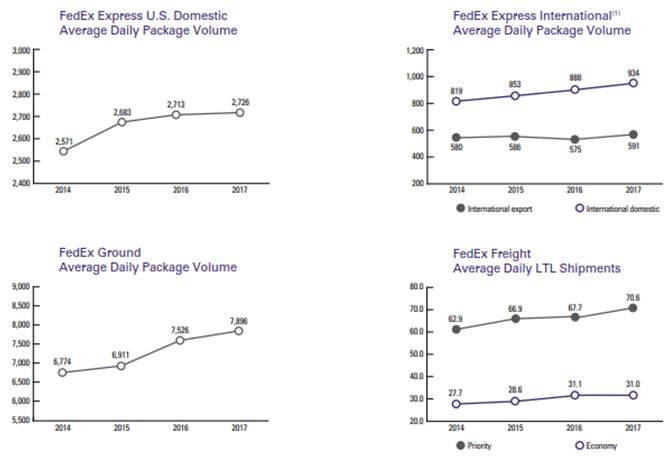
Government Policies: Freight transport industry is “subject to regulation under a wide variety of U.S. federal and state and non-U.S. regulations, laws, and policies” (FedEx 2017). Congress and the Executive Branch have worked closely with States and industry to develop a more sophisticated understanding of our nation’s freight transportation needs (NFSP 2017). There is no guarantee that these regulations won’t change in ways that are unfavorable for industry. Actions considered by Congress regarding labor laws could promote unionization of employees and causing workforce challenges. Policies driven by current events can also cause major foreign exchange impacts causing the industry to get impacted. Freight volumes are subject to trade agreements and foreign market climates as they dictate how much product will be moving. There is substantial uncertainty surrounding the UK’s June 2016 vote to leave the EU (FedEx 2017). This could cause an economic downtown and more regulations to face. Also during 2016 EPA found that aircraft engine GHG emissions can cause pollution and may endanger people’s welfare. This is now a prerequisite of new certification standard for aircraft emissions. These policies may be abided and digested by existing major players but certainly serve as a threat for new entrants.
Bargaining Power of Suppliers
For the freight transport industry, suppliers cover a distinct range. On one end fuel, aircrafts and trucks to the other end where there are packaging materials, printers and papers. The bargaining power of suppliers is relatively low as it makes more economic sense for FedEx to purchase its transportation vehicles in bulk from one company. FedEx being a huge company with a high need has the bargaining power. FedEx purchases its aircrafts from Boeing and currently owns 598 aircrafts. Jet fuel is purchased from various suppliers and because of FedEx’s indexed fuel surcharge, there is no hedging. The fuel needs to for vehicles are met by retail purchases where FedEx gets various discounts. From a labor supply standpoint, though majority of the workforce is not unionized, the pilots “are represented by the Air Line Pilots Association, International (“ALPA”) and are employed under a collective bargaining agreement that took effect on November 2, 2015. The collective bargaining agreement is scheduled to become amenable in November 2021, after a six-year term. In addition to our pilots at FedEx Express, certain of FedEx Express’s non-U.S. employees are unionized” (FedEx 2017).
Bargaining Power of Buyers
While for normal consumers the bargaining power is non-existent, it is high for corporate clients. As corporations have huge volumes of freight and relatively low switching costs, they have more leverage. The buyers are likely to shop for a favorable price and purchase selectively. Buyers, sure that they can always find alternative suppliers, may play one company against another, as they do in aluminum extrusion (Porter 1979). FedEx, along with its competitors in the market, offers volume discounts and percentage rebates to a lot of its corporate customers along with bundled pricing. Irrational pricing environment can limit our ability not only to maintain or increase our prices (including our fuel surcharges in response to rising fuel costs), but also to maintain or grow our market share (FedEx 2017).
Threat of Substitute Products
Technological advances and enhanced data storage and communication capabilities in the current environment have served as a substitute for the need to delivering documents and sensitive literature. E-signature capabilities and doc-filling services have reduced the need of notary services and hand signed documents. As this has taken away a small portion of the business, the need of having hard copy documents hand delivered still exists. There are only a few ways to deliver parcels. Also with lower switching costs, the need to search for substitutes is minimal. FedEx international priority package revenue increased by 2% from 2016 to 2017 as international priority freight revenue experienced a 9% increase during the same timeframe. The international export average daily volumes experienced a 3% growth as well reasoning from incremental volumes of priority box shipments and international export growth from Asia and Europe.
Rivalry Amongst Competing Firms
The transportation and business services markets are both highly competitive and sensitive to price and service, especially in periods of little or no macroeconomic growth. Some of our competitors have more financial resources than we do, or they are controlled or subsidized by foreign governments, which enables them to raise capital more easily (FedEx 2017). Competition with regional transportation companies operating smaller and less capital-intensive transportation networks exists as well as with startups using crowdsourcing for local market needs. Amazon is testing its own delivery service to rival FedEx and UPS (Bloomberg Technology, 2017). The crux of the issue for the e-commerce leader is that its shipping costs soared 32% to $11.5 billion in 2015, while sales rose about 20% (Barnes, 2016). Currently a customer making up roughly 3% of FedEx’s revenues, Amazon can become a major competitor by bundling transportation with the rest of its service offerings. As part of its new delivery service, Amazon would pick up packages filled with ordered items from third-party merchants selling in its marketplace and deliver the items directly to customers’ homes. The company might still have some use for its partnerships with FedEx and UPS for delivery, but the in-house delivery program would allow Amazon to logistically control the flow of goods for its partner merchants (Bloomberg Technology, 2017).
USPS, though a competitor, is also a major vendor and customer of FedEx. In 2013, FedEx Express entered into a new seven-year agreement with the USPS under which FedEx Express provides airport-to-airport transportation of USPS Priority Mail Express and Priority Mail within the United States. On February 22, 2017, the parties entered into an amendment to the agreement whereby the initial renewal period provided in the agreement was exercised in part and the agreement’s period of performance was extended through September 29, 2024. FedEx Express also provides transportation and delivery for the USPS’s international delivery service called Global Express Guaranteed under a separate agreement (FedEx, 2017).
In a study conducted by Consumer Reports, FedEx was the least expensive courier for second-day service in 97 percent of the comparisons. However, in a bit more than half of these head-to-head comparisons, FedEx was less than a dollar cheaper than UPS. UPS had the lowest prices in only 3 percent of the cases for second-day delivery. FedEx had the best deal in only 27 percent of the 30 trials for overnight delivery and in just 13 percent of the cases for third-day delivery.
With no doubt, the ever-going rivalry between FedEx and UPS exists. This, however has matured over the years and both companies have joined forces to reach out to the government in hopes to “simplify taxes, invest in transport infrastructure, and expand international trade while keeping it fair” (WSJ, 2017).
Gross margin and operating margin comparison for FedEx and UPS for
Years 2007 – 2016.
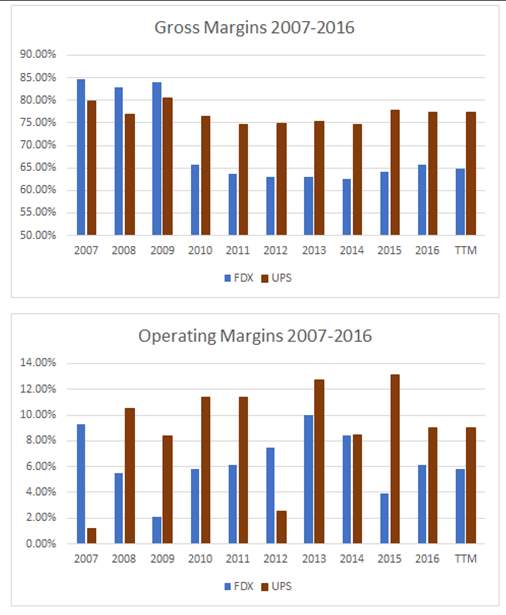
Porter’s Five Forces – Fedex Office
FedEx Office represents a printing and business service division of FedEx. Printing solutions serve consumer and business industry. Consumers use the print services for home projects such as canvas, posters, invites; business solutions of media, banners, signs, presentations, manuals and manuals. FedEx Office also offers cloud solutions for document management and online printing.
The printing industry is fragmented. There are not major companies in the print service industries and of the four largest printing companies; industry revenue is estimated at 10%. Most commercial printers are owned privately. The industry’s low barriers to entry and improvements in printing technology have also encouraged the entrance of small businesses dominate this industry service. Due to small companies underperforming, many have consolidated; the increase of digital media also affect the demand for printing. (IBIS, 2017)
Threat of new entrants
The threat of new entrants is considered at a medium level of concern. Print solutions are frequently found on local levels. Print solutions are easily replicable business services; this is somewhat balanced by the consolidation of many companies. In addition to the print services, cloud data solutions are offered from other sources such as google and Microsoft (IBIS, 2017).
Threat of substitutes
The threat of substitutes for printing services is high. Print services are often replaced with digital media resulting in a reduction of print services. Competitors and other solutions also contribute to the likelihood of a given industry losing business to substitutes in the printing industry.
Bargaining power of customers
The bargaining power of customers is high. Customers have many options for personal or business printing via small and large companies offering similar print services. The price differentiation, quality of service, and speed delivery are important aspects for the customers. Fedex Office complements the other industries served by its cloud data. Business services for remote workers and accessibility would drive to brands easily identified and available to use cloud data, print, and mail services.
Bargaining power of suppliers
The bargaining power of suppliers is low. Print solutions and resources readily available. Printing relies on paper resources. The technology side of the business relies on support server storage and cloud data. FedEX Office combats this with strategic partnerships with other organizations as they paired up with Microsoft and Kinkos (Samon, 2004).
Industry rivalry
The industry rivalry of office solutions and printing is relatively high. One of FedEX major competitors UPS offers similar services for local printing solutions and no hassle printing. Other competitors, such as vistaprint offer very competitive pricing with strong ecommerce for the customer experience.
The printing industry has been on the decline due to online platforms and digital media. FedEx serving the cloud data solutions along with print and shipping services supports its brand as a service provider. Ecommerce and manufacturing represents some of the largest opportunities for print services as well as the shipping/delivery aspect of online sales (IBIS, 2017). Ecommerce is expected to reach $4.5 Trillion by 2021 (Shopify).
Global Retail Ecommerce Sales Will Reach $4.5 Trillion by 2021
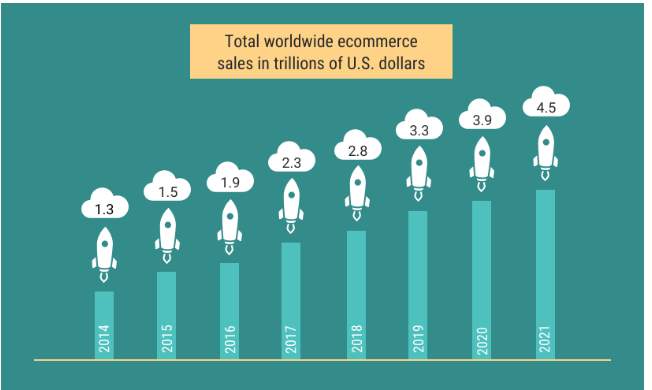
Trends in advertising (16.3%) and publications (18.6%) will influence printing.
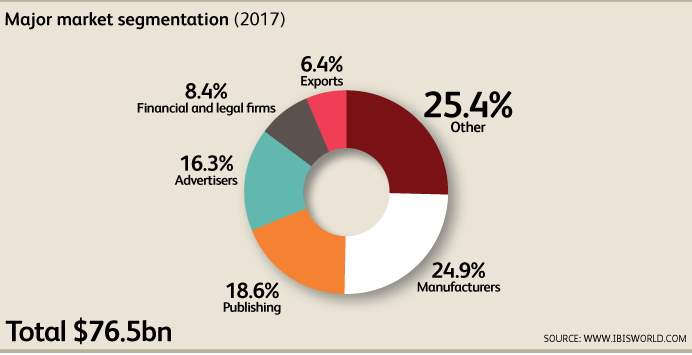
As commercial printing and advertising continue to be a driving force for the printing industry, Statistical research on ad expenditure would support business services of FedEx Office.

It is estimated growth of advertising dollars will grow between 2015 to 2021. While much of it may be in TV advertising, will be followed by investments in digital advertising (Statista).
Media advertising spending in the United State from 2015 to 2021
(in billions U.S. dollars)
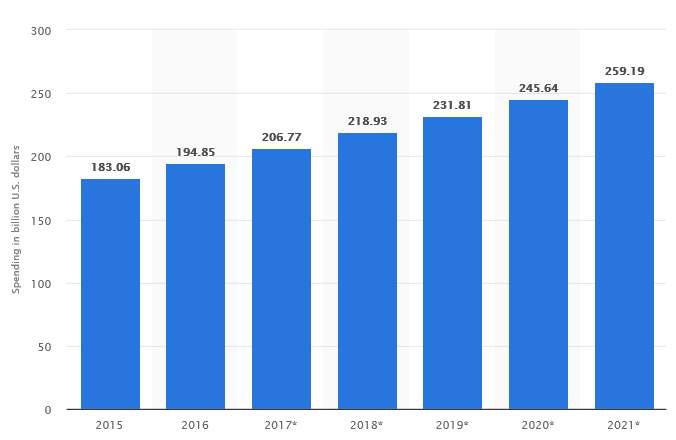
The growth trends in ecommerce, advertising, and marketing are similarly reflected in FedEX Corporate Revenue.
FedEx Corporate Revenue FY 2008 to FY 2017 (in billion U.S Dollars)
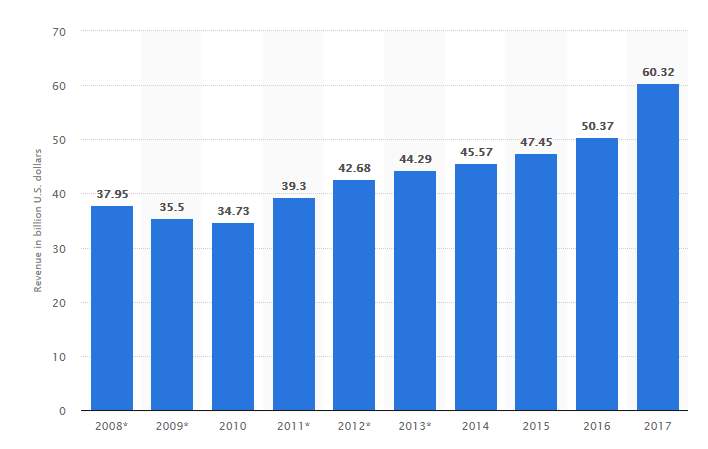
| 2015 | 2016 | 2017 | ||
| Advertising | Billions | $ 183.06 | $ 194.85 | $ 206.77 |
| Company Revenue | Billions | $ 47.45 | $ 50.37 | $ 60.32 |
| E-Commerce | Trillions | $ 1.50 | $ 1.90 | $ 2.30 |
The diversification of products and services enables FedEx to sustain in the industry as a major player. The demand for shipping options itself promise growth in this sector. Competitive pricing and delivering on promised goods and reputation will be as strength to carry FedEX forward to gain market share of its largest competitor FedEX.
REFERENCES
“December 18, 2006 to be Busiest Day in FedEx History.” Traffic World (2006): 1. ProQuest. 20 Feb. 2018 . History. (n.d.). Retrieved February 19, 2018, from http://www.fedex.com/al/about/company-info/history.html#tab4
Bhandari, R. (2013). Impact of Technology on Logistics and Supply Chain Management. IOSR Journal of Business and Management. 12(4) pp19-24.
Davies, A. (2015, May 05). THE WORLD’S FIRST SELF-DRIVING SEMI-TRUCK HITS THE ROAD. WIRED. Retrieved from https://www.wired.com/2015/05/worlds-first-self-driving-semi-truck-hits-road/
Export-Import Bank of India. (2013). Comparison of Labor Laws. Export-Import Bank of India. Retrieved from https://www.eximbankindia.in/Assets/Dynamic/PDF/Publication-Resources/ResearchPapers/Hindi/11file.pdf.
FedEx.com
Global Ecommerce Statistics [Infographic] and 10 International Growth Trends You Need to Know. (n.d.). Retrieved February 24, 2018, from https://www.shopify.com/enterprise/global-ecommerce-statistics
Halik, J. (2012). The application of PEST analysis based on EBRD and IBRD methodology. Central European Business Review, 1(3), 14–21.
Harrup, A. (2017, November, 21). Mexico to Raise Minimum Wage Above Inflation. The Wall Street Journal. Retrieved from https://www.wsj.com/articles/mexico-to-raise-minimum-wage-above-inflation-1511298093.
IBISWorld. (2017, August). 49222 Couriers & Local Delivery Services in the US. Retrieved from IBISWorld Database.
McGinley, Devin (June 2017) IBISWorld Industry Report 32311 Printing in the US , IBIS World, Inc.
(New York residents only). (n.d.). Leading logistics companies in U.S. – net revenue 2017 | Ranking. Retrieved February20,2018,from https://www.statista.com/statistics/184538/20-leading-us-logistics-companies-by-net-revenue/
Phillipines Daily Minimum Wage Data. Retrieved from http://www.nwpc.dole.gov.ph/pages/ncr/cmwr.html
Ryu, M. J., Han, M., & Choi, S (2014). FEDEX IN CHINA. Journal of the International Academy for Case Studies, 20 (3).
Samson, T. (2004). FedEx Kinko’s Delivers Remote Printing. Infoworld, 26(46), 52.
Silkin, L. (2017). Employment Law in China- An Overview. Retrieved from http://www.lewissilkin.com/Insights/Employment-law-in-China-an-overview
Silkin, L. (2017). Employment Law in Phillipines- An Overview. Retreived from www.lewissilkin.com/Insights/Employment-law-in-Philippines—an-overview
Singapore Ministry of Manpower. (2011). Guide on Employment Laws for Employers. Retrieved from https://www.tafep.sg/publication/guide-employment-laws
Smith, A. (2014, April 3). Older Adults and Technology Use. Pew Research Center. Retrieved from http://www.pewinternet.org/2014/04/03/older-adults-and-technology-use/
Transport and Logistics Skills Council. (2014). Environment Scan. Transport and Logistics Skills Council Ltd. Retrieved from http://tlisc.org.au/industry-intelligence/previous-e-scans/
UNESCO Institute of Statistics. (2017, September). Literacy Rates Continue to Rise from One Generation to the Next. UNESCO. Retrieved from http://uis.unesco.org/sites/default/files/documents/fs45-literacy-rates-continue-rise-generation-to-next-en-2017_0.pdf.
United States Department of Commerce E-Commerce Retailing Data. Retrieved from https://www.census.gov/retail/mrts/www/data/pdf/ec_current.pdf
United States Department of Labor Unemployment Rate. Retrieved from https://data.bls.gov/timeseries/LNS14000000.
UPS, FedEx get approval for express services in more Chinese cities. (2014, August 14). Retrieved from https://www.reuters.com/article/us-united-parcel-fedex-china/ups-fedex-get-approval-for-express-services-in-more-chinese-cities-idUSKBN0GE0JQ20140814
Williams, M., & Frolick, M. (2001). The Evolution of EDI for Competitive Advantage: The FedEx Case. Information Systems Management. 18(2), pp1-7.
World Bank Global Unemployment Data. Retrieved from https://data.worldbank.org/indicator/SL.UEM.TOTL.ZS?view=chart.
Zipser, D., Chen, Y., & Gong, F. (2016, March). Here comes the modern Chinese Consumer. McKinsey & Co. Retrieved from https://www.mckinsey.com/industries/retail/our-insights/here-comes-the-modern-chinese-consumer.
Cite This Work
To export a reference to this article please select a referencing stye below:
Related Services
View allRelated Content
All TagsContent relating to: "Business Analysis"
Business Analysis is a research discipline that looks to identify business needs and recommend solutions to problems within a business. Providing solutions to identified problems enables change management and may include changes to things such as systems, process, organisational structure etc.
Related Articles
DMCA / Removal Request
If you are the original writer of this dissertation and no longer wish to have your work published on the UKDiss.com website then please:




